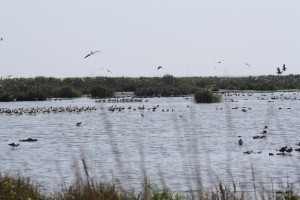 Many of the salt marsh and barrier island restoration projects I’ve described in previous posts are pretty big scale- it would be challenging for an individual to plan and carry out offshore dredging or large-scale marsh terrace construction. But is there a way to contribute in some small fashion to these bigger projects? Given how important these areas are to coastal populations, it would be only right, I think, for those of us living under their protection to give back in some way. And there must be options for smaller scale restoration as well.
Many of the salt marsh and barrier island restoration projects I’ve described in previous posts are pretty big scale- it would be challenging for an individual to plan and carry out offshore dredging or large-scale marsh terrace construction. But is there a way to contribute in some small fashion to these bigger projects? Given how important these areas are to coastal populations, it would be only right, I think, for those of us living under their protection to give back in some way. And there must be options for smaller scale restoration as well.
As I searched for opportunities to contribute to salt marsh and barrier island restoration, it became very clear that current efforts are largely on a watershed-by-watershed basis- concerned community members, governmental officials, and scientists had organized themselves to investigate and address their own concerns. I think this is fantastic on several levels: first, the status reports for projects that have been initiated suggest that a group of people working together can make a real difference; second, smaller organizations tend to be in regular need of volunteers (and some of the groups listed below were very clear that they welcome any and all help). I think this also means that, if the area you want to work in is not currently represented by a restoration organization or project, there are a lot of people out there who can give you some guidance on starting your own project. What follows is by no means an exhaustive list, but hopefully it gives you a sense of how you can contribute and where to start your search for volunteer opportunities.
New England
- Buzzards Bay Coalition– you can participate in salt marsh (and other ecosystem) monitoring and community outreach
- Salem Sound CoastWatch– help with salt marsh monitoring and restoration projects
- Mass Office of Coastal Zone Management- they have a training program for invasive species monitoring and participate in other salt marsh projects
- Save the Bay– concentrating on Narragansett Bay, their projects include monitoring, restoration, even high tide observation- you can also sign up for regular volunteer listings
- Mass Audubon has a Salt Marsh Science Project that schools on the North Shore can participate in
Farther south
- Chesapeake Bay Environmental Center– participate in both restoration and education programs
- Florida Dept. of Environmental Protection uses volunteers for restoration plantings and other activities through their Ecosystem Restoration Section
- And for those really south of the border, WetlandCare Australia works on several projects in conjunction with government efforts
What if I want to contribute in a different way? Remember that a large part of any restoration effort is convincing governmental bodies and the public that this work is important- whether it’s restoring tidal flow or creating new fish nursery habitat, these projects don’t happen without enough public and private support, so add your voice to the conversation. If you don’t live near the coast, there is still plenty work to be done- freshwater wetlands around the world are also greatly at risk. And remember that small actions do add up, whether positively or negatively- when you’re enjoying a day on the beach or fishing offshore or buying shrimp at your local supermarket, think about how you can modify your actions to reduce any environmental impact, perhaps by limiting what doesn’t make it back to the dock or ensuring that the resources you consume are sustainably harvested. And for those of us upriver, I think we need to be more cognizant that what flows away from us flows toward someone or something else.
